
Aswan is a city in Southern Egypt, and is the capital of the Aswan Governorate.

Satet,Satit or Satjet, Satjit in Ancient Egyptian, Greek: Satis, also known by numerous related names, was an Upper Egyptian goddess who, along with Khnum and Anuket, formed part of the Elephantine Triad. A protective deity of Egypt's southern border with Nubia, she came to personify the former annual flooding of the Nile and to serve as a war, hunting, and fertility goddess.

The Middle Kingdom of Egypt is the period in the history of ancient Egypt following a period of political division known as the First Intermediate Period. The Middle Kingdom lasted from approximately 2040 to 1782 BC, stretching from the reunification of Egypt under the reign of Mentuhotep II in the Eleventh Dynasty to the end of the Twelfth Dynasty. The kings of the Eleventh Dynasty ruled from Thebes and the kings of the Twelfth Dynasty ruled from el-Lisht.

Elephantine is an island on the Nile, forming part of the city of Aswan in Upper Egypt. The archaeological digs on the island became a World Heritage Site in 1979, along with other examples of Upper Egyptian architecture, as part of the "Nubian Monuments from Abu Simbel to Philae".
The history of ancient Egypt spans the period from the early prehistoric settlements of the northern Nile valley to the Roman conquest of Egypt in 30 BC. The pharaonic period, the period in which Egypt was ruled by a pharaoh, is dated from the 32nd century BC, when Upper and Lower Egypt were unified, until the country fell under Macedonian rule in 332 BC.
A nomarch was a provincial governor in ancient Egypt; the country was divided into 42 provinces, called nomes. A nomarch was the government official responsible for a nome.

The Twelfth Dynasty of ancient Egypt is a series of rulers reigning from 1991–1802 BC, at what is often considered to be the apex of the Middle Kingdom. The dynasty would periodically expand its territory from the Nile delta and valley South beyond the second cataract and East into Canaan.
A nome was a territorial division in ancient Egypt.
The Philae temple complex is an island-based temple complex in the reservoir of the Aswan Low Dam, downstream of the Aswan Dam and Lake Nasser, Egypt.

Amenemhat I, also known as Amenemhet I, was a pharaoh of ancient Egypt and the first king of the Twelfth Dynasty of the Middle Kingdom.

Nubkaure Amenemhat II, also known as Amenemhet II, was the third pharaoh of the 12th Dynasty of ancient Egypt. Although he ruled for at least 35 years, his reign is rather obscure, as well as his family relationships.

Senusret I also anglicized as Sesostris I and Senwosret I, was the second pharaoh of the Twelfth Dynasty of Egypt. He ruled from 1971 BC to 1926 BC, and was one of the most powerful kings of this Dynasty. He was the son of Amenemhat I. Senusret I was known by his prenomen, Kheperkare, which means "the Ka of Re is created." He expanded the territory of Egypt allowing him to rule over an age of prosperity.
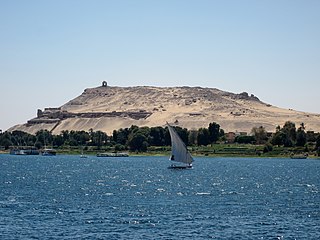
Qubbet el-Hawa or "Dome of the Wind" is a site on the western bank of the Nile, opposite Aswan, that serves as the resting place of ancient nobles and priests from the Old and Middle Kingdoms of ancient Egypt. The necropolis in use from the Fourth Dynasty of Egypt until the Roman Period.
Amenemḥat or Amenemhēt, hellenized as Ammenémēs or as Ammanémēs, is an Ancient Egyptian name meaning "Amun is in front". Amenemhat was the name of a number of kings, princes and administration officials throughout ancient Egyptian history.

Nubia is a region along the Nile river encompassing the area between the first cataract of the Nile and the confluence of the Blue and White Niles, or more strictly, Al Dabbah. It was the seat of one of the earliest civilizations of ancient Africa, the Kerma culture, which lasted from around 2500 BC until its conquest by the New Kingdom of Egypt under Pharaoh Thutmose I around 1500 BC, whose heirs ruled most of Nubia for the next 400 years. Nubia was home to several empires, most prominently the Kingdom of Kush, which conquered Egypt in the eighth century BC during the reign of Piye and ruled the country as its 25th Dynasty.
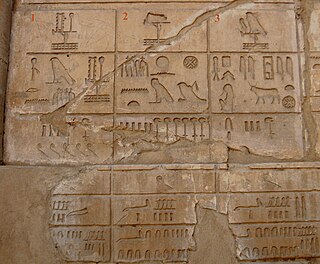
Inebu-hedj was one of 42 nomes in Ancient Egypt.
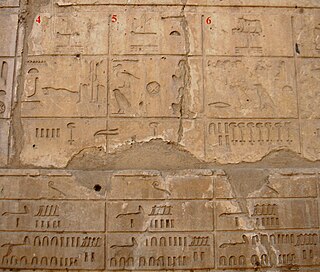
Khaset was one of 42 nomes in ancient Egypt.
This page list topics related to ancient Egypt.
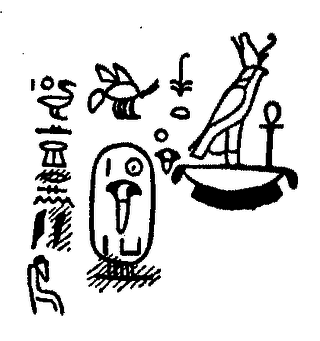
Segerseni was an ancient Egyptian or Nubian chieftain of Nubia, likely reigning concurrently with the end of the 11th and beginning of the 12th Dynasty during the early Middle Kingdom.
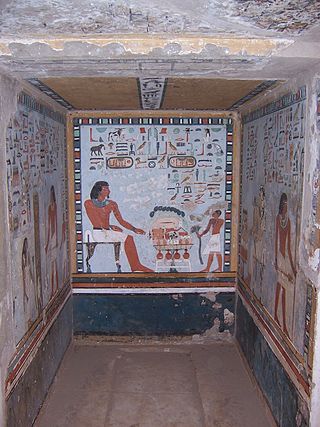
Sarenput II, also called Nubkaurenakht was an ancient Egyptian nomarch during the reign of pharaohs Senusret II and Senusret III of the 12th Dynasty.















